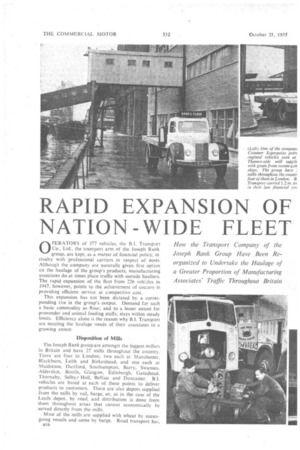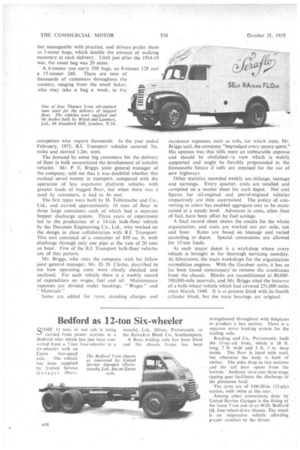RAPID EXPANSION OF NATION WIDE FLEET
Page 50

Page 51

Page 52

If you've noticed an error in this article please click here to report it so we can fix it.
OPERATORS of 377 vehicles, the B.I. Transport Co., Ltd., the transport arm of the Joseph Rank group, are kept, as a matter of financial policy, in rivalry with -professional carriers in respect of costs. Although the company are naturally given first option on the haulage of the group's products, manufacturing associates do at times place traffic with outside hauliers. The rapid expansion of the fleet from 226 vehicles in 1947, however, points to the achievement of success in providing efficient service at competitive cost.
• This expansion has not been dictated by a corresponding rise in the group's output. Demand for such a basic commodity as flour, and to a lesser extent for provender and animal feeding stuffs, stays within steady limits. Efficiency alone is the reason why B.I. Transport are meeting the haulage needs of their associates to a growing extent.
Disposition of Mills
The Joseph Rank group are amongst the biggest millers in Britain and have 27 mills throughout the country. '[here are four in London; two each at Manchester. Blackburn, Leith and Birkenhead, and one each at Maidstone, Dartford, Southampton, Barry, Swansea, Aldershot, Bootle, Glasgow, Edinburgh, Gateshead. Thornaby, Selby,Hull, Belfast and Doncaster. B.I. vehicles are based at each of these points to deliver products to customers. There are also depots supplied from the mills by rail, barge, or, as in the case of the Leeds depot, by road, and distribution is done from them throughout areas that cannot economically be served directly from he mills.
Most of the mills are supplied with wheat by oceangoing vessels and some by barge. Road transport has, rit6 however, been found cheaper for the delivery of wheat to a number of inland mills previously fed by barge. Twenty-two Foden-Duramin bulk-wheat vehicles are operated between the Liverpool mill and the Manchester and Blackburn mills, from Gateshead to Tbornaby, Southampton to Aldershot, Leith to Edinburgh, and from ocean store at Glasgow to the mill in that city.
Although the Fodens carry only 15 tons, whereas a barge takes 60 tons, they travel much faster. On the 40-mile trip between Liverpool and Blackburn, for example, a barge took a week, whereas one vehicle can deliver two loads in a day. In the north-western area, where 15 of the Fodens operate, vehicles are interchanged on the various journeys and do the work of a far greater number of barges. In Glasgow, where the haul is short, two Fodens each make about eight deliveries a day and since June, 1947, have carried 340,000 tons and covered 180,000 miles.
Make-up of Fleet Vehicles of this make, with Gardner engines, have been chosen as the standard type for the heavier range. There are 103 platform eight-wheelers and nine built for the transport of flour in bulk. Both rear axles of all eight-wheelers are driven. A number of Thames, Bedford, A.E.C., Vulcan, Thornyeroft, Karrier and Austin models of 2-6-ton capacity largely remains from the time, shortly after the war, when new vehicles were scarce and a policy of standardization was impossible.
A decision was taken, however, to adopt the Commer Superpoise petrol-engined 6-tonner as the standard .medium-sized type. There are now 141 of these, but this figure is diminishing because of the desire to convert the fleet entirely to oilers. Albion Chieftain 8-tonners are being purchased and B.I. Transport have 82 so far. Of the total fleet, 224 are oilers and 153 petrol-engined. Alkaline batteries are standardized and results so far have been good.
Vehicles are loaded to rated weight capacity, which is the reason why makes of vehicle with a name for ability to withstand hard work have been selected. Bags of flour weigh 10 stone each—seemingly rather heavy but manageable with practice, and drivers prefer them to 5-stone bags, which double the amount of walking necessary at each delivery. Until just after the 1914-18 war, the usual bag was 20 stone.
A 6-tonner can carry 100 bags, an 8-tonner 128 and a 15-tonner 240. There are tens of thousands of customers throughout the country, ranging from the small baker, who may take a bag a week, to big
companies who require thousands. In the year ended February, 1955, B.I. Transport vehicles covered 7m. miles and carried 1.2m. tons.
The demand by some big customers for the delivery of flour in bulk necessitated the development of suitable vehicles. Mr. P. E. Briggs, joint general manager of the company, told me that it was doubtful whether this method saved money in transport, compared with the operation of less expensive platform vehicles with greater loads of bagged flour, but when there was a need by customers, it had to be met.
The first types were built by H. Tollemache and Co., Ltd., and carried approximately 10 tons of flour in three large containers each of which had a separate hopper discharge system. Three years of experiment led to the production of a 14-ton bulk-flour vehicle by the Duramin Engineering Co., Ltd., who worked on the design in close collaboration with B.I. Transport. This unit consisted of a container of 850 cu. ft. with discharge through only one Pipe at the rate of 20 tons an hour. Five of the B.I. Transport bulk-flour vehicles are of this pattern.
Mr. Briggs, who runs the company with his fellow joint general manager, Mr. D. D. Clarke, described to me how operating costs were closely checked and analysed. For each vehicle there is a weekly record of expenditure on wages, fuel and oil. Maintenance expenses are divided under headings, "Wages" and " Materials."
Sums are added for tyres, standing charges and
incidental expenses, such as tolls, for which item, Mr. -Briggs said, the company "begrudged every penny spent." His opinion was that tolls were an unbearable expense and should he abolished—a view which is widely supported and might be forcibly propounded in the foreseeable future if tolls are imposed for the use of new highways.
Other statistics recorded weekly are mileage, tonnage and earnings. Every quarter, costs are totalled and compiled on a master sheet for each depot. Net cost figures for oil-engined and petrol-engined vehicles respectively are then ascertained. The policy of converting to oilers has enabled aggregate cost to be. .mainrained at a steady level. Advances in costs, other than of fuel, have been offset by fuel savings.
A final record sheet shows the results for the whole organization, and costs are worked out per mile, ton and hour. Rates are based on tonnage and varied according to depot. Special concessions are allowed for 15-ton toads.
At each major depot is a workshop where every vehicle is brought in for thorough servicing monthly. At Silvertown, the main workshops for the organization recondition engines. With the Gardner units, it has so far been found unnecessary to remove the crankcases from the chassis. Blocks are reconditioned at 80,000100,000-mile intervals, and Mr. Briggs cited the instance of a bulk-wheat vehicle which had covered 251,000 miles since March, 1948. It is at present fitted with its fourth cylinder block, but the main bearings arc original.




































































































